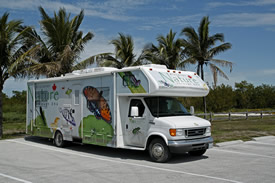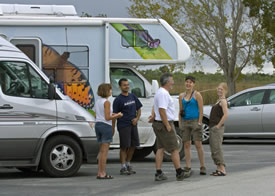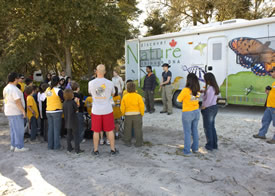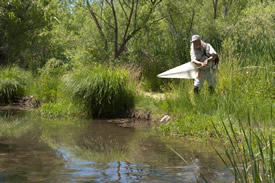The BIObus Project
Did I hear him right? Dr. Paul Hebert, Head of the Biodiversity Institute of Ontario (and recognized father of DNA Barcoding) had just told me that he was creating a position, specifically for me, at the University of Guelph.
“What would you say,” he began, “...if I bought you a 30-foot RV, and deployed you, along with a crew of grad students and post-docs, all over North America to collect and photograph invertebrates for DNA Barcoding?”
When I picked myself up off the floor... I heard myself say, “Okay—that sounds good.”
That meeting ultimately culminated in the launch of what soon became known as “the BIObus Project”.
My first assignment was to design full-wrap graphics for the vehicle, using my inventory of nature photographs.
Paul Hebert is a visionary. Our colorful BIObus turned heads everywhere we went. It became an unofficial mascot for the University, and we became Ambassadors for DNA Barcoding, the University and for Biology in general.
When we weren't out on the road, we were booked to set up displays at regional fairs and botanic gardens where we met the public, other researchers and most importantly, children who constantly impressed us with their knowledge and endless curiosity about Nature.
BIObus was a Public Relations dream. Heads turned and smart phones rose as we drove down the street. Children pointed and you could read their parents' lips as they read “Discover Nature Through DNA” out loud. People in passing cars honked and waved.
Folks stopped us to chat at rest-stops and shopping malls—any time we weren't on the move. We distributed quite a lot of literature promoting DNA Barcoding and the University all over the continent.
We were treated like rock stars. People would even ask where they volunteer to be part of a future BIObus expedition.
Our typical day started first thing after breakfast, tending our passive traps (pitfall, malaise, pan traps—we even used underwater traps for aquatic invertebrates). During the day we used butterfly nets to hand sample the environment. Before dinner, it was time to process what we had collected.
At dusk, out came the UV lights and night sheets for nocturnal insects. After several hours of hand collecting off the sheets, we'd return to BIObus to sort, preserve and database everything before hitting the bunks, sometimes after 3am. On a few occasions, we had collected so much material that the sun was coming up before we could hit the sheets.
During the first four years on the road, we collected, preserved and databased countless invertebrates across Canada (visiting 21 National Parks from Vancouver Island to Newfoundland) and from coast to coast in the southern US (Florida to California).
We acquired permits to collect specimens in Canada’s spectacular National Parks during the summer months and got an early start on our season by traveling through the southern US. We were granted permits to collect invertebrates in the magnificent State Parks of Florida, Texas, Arizona and California.
We did presentations for Park Staff and their Visitors while we were embedded in the environment we were sampling. It was an amazing experience for everyone involved.
We were also invited to do lab work—harvesting DNA and photographing each specimen from some of the finest insect collections in North America. We spent a week or so at Texas A&M, Colorado State, Mississippi State, and the Canadian National Collection in Ottawa, to name a few.
Long 16+ hour days were the norm, 7 days a week. Our only time off was to sleep. When it happened to rain, we'd have a laundry day or shop for provisions until the weather lifted.
Several private collectors opened their insect drawers for us, donating one leg from each specimen, to help populate BIO’s digital database of life back at the University (BOLD: the Barcode Of Life Database).
After being presented with the Norman Criddle Award (Canadian Amateur Entomologist of the Year), I thanked Dr. Hebert for this dream job. His response was, “Jay, I’m an opportunist. I recognized a great opportunity and I simply took advantage of it.”
I am very grateful to Dr. Hebert, and to the Entomological Society of Canada for the unexpected national recognition.





